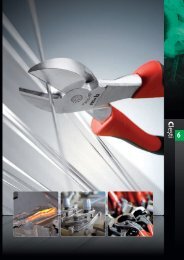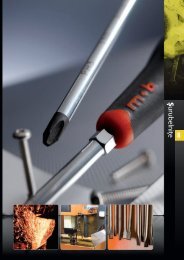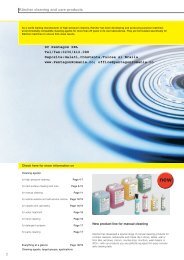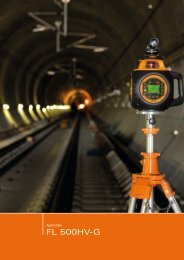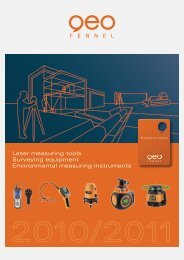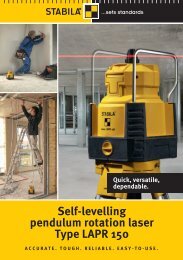LG20 User Guide - GeoSystems
LG20 User Guide - GeoSystems
LG20 User Guide - GeoSystems
You also want an ePaper? Increase the reach of your titles
YUMPU automatically turns print PDFs into web optimized ePapers that Google loves.
•<br />
<strong>LG20</strong> Crossbeam Generator<br />
<strong>User</strong> <strong>Guide</strong><br />
Introduction<br />
Thank you for choosing the Spectra Precision ® Laser <strong>LG20</strong> from the Trimble ®<br />
family of precision products. This simple-to-use tool allows you to perform<br />
elevation leveling or vertical plumb work, such as ceiling installations, or<br />
laying out wall lines and putting up wall partitions. You can also use the laser<br />
outdoors for leveling and aligning applications (optional HR250 receiver<br />
required).<br />
Before using the laser, be sure to read this operator’s manual carefully.<br />
Included in it is information about setting up, using, and maintaining the<br />
laser. Also included in this manual are CAUTIONS and Notes. Each of these<br />
words represents a level or danger or concern. A CAUTION indicates a hazard<br />
or unsafe practice that could result in minor injury or property damage. A<br />
Note indicates important information unrelated to safety.<br />
Your comments and suggestions are welcome; please contact us at:<br />
Trimble Construction Division<br />
5475 Kellenburger Road<br />
Dayton, Ohio 45424-1099 U.S.A.<br />
Phone: (937) 245-5600<br />
(800) 538-7800<br />
FAX: (937) 233-9004<br />
Internet: www.trimble.com<br />
Features<br />
2<br />
1<br />
3<br />
4<br />
5<br />
6<br />
1. Power/Mode Button<br />
2. Manual LED<br />
3. Receiver Button<br />
4. Power (solid)/Receiver (flashing)<br />
LED<br />
5. Exit Window for Beam(s)<br />
6. Battery Housing<br />
Laser Safety<br />
The pocket laser uses a Class 2 laser,<br />
which complies with the requirements<br />
based on the IEC825-1/EN60825<br />
standards (Class 2 based on 21CFR<br />
1041). This laser may be operated<br />
without the need for any additional<br />
protective measures. Nevertheless, as with the sun, care should be taken to<br />
avoid looking directly into the light source.<br />
CAUTION: Never look directly into the laser beam.<br />
Please keep the pocket laser out of the reach of children.<br />
HR250 Receiver<br />
1. Power and Audio Button – turns<br />
the receiver on/off and changes the<br />
audio to loud, soft, and off.<br />
2. Marking Notches (both sides) –<br />
align with the on-grade portion of<br />
the photocell and are used to mark<br />
elevation readings. The marking<br />
notches are 50 mm (2 in.) from the<br />
top of the receiver.<br />
3. Grade-Sensitivity Button— allows<br />
you to select the receiver’s on-grade<br />
4<br />
3<br />
2<br />
1<br />
5<br />
6<br />
2<br />
7<br />
sensitivities, which include fine: 1.5 mm ( 1 /16 in.) and medium: 3 mm<br />
( 1 /8 in.).<br />
4. LEDs – show the position of the receiver relative to the laser beam (above<br />
grade, on grade, or below grade).<br />
5. Front and Back Liquid Crystal Displays (LCDs) – show the power, audio,<br />
elevation, grade sensitivity, out-of-level, and battery status. The LCDs also<br />
show when the laser has been bumped out of level.<br />
6. Photocell – detects the laser beam when it strikes the receiver. If the<br />
photocell does not detect the laser beam for 30 minutes, the receiver<br />
shuts off automatically.<br />
7. Audio Port – is the opening the sound comes out of.<br />
www.trimble.com<br />
– 2 –<br />
– 3 – – 4 –<br />
HR250 Receiver (cont.)<br />
08. Clamp-Tab Recess – is the area that<br />
the general-purpose clamp’s release<br />
tab fits into.<br />
09. Label – shows the serial number and<br />
manufacturing date.<br />
8<br />
9<br />
General-Purpose Clamp<br />
The C59 general-purpose clamp allows the receiver to be attached to a survey<br />
rod or wooden pole.<br />
Features and Functions<br />
1<br />
0002-8210 Universal Accessory<br />
1 M (4 Ft) Marks Elevations with 1 /4–20 Columns with Strap or<br />
Tripod Mount<br />
Bungee Cord<br />
10. Battery Housing – holds 2 AA<br />
alkaline batteries.<br />
11. Battery Door – holds the batteries<br />
securely in place.<br />
10<br />
11<br />
2<br />
3<br />
5<br />
4<br />
Ceiling with 0002-3480<br />
Ceiling Plate<br />
Pipes/Conduit<br />
1. Release Tab – allows the receiver to be locked onto or released from the<br />
general-purpose clamp.<br />
2. Jaws – close/open so that the general-purpose clamp can be attached to or<br />
released from a survey rod or wooden pole.<br />
3. Jaws Screw – controls the closing/opening of the jaws.<br />
4. Reading Edge – aligns with the receiver’s on-grade marking notches.<br />
5. Bubble Screw Holes – are where the optional 1277-6251S rod bubble kit<br />
is mounted.<br />
– 5 –<br />
– 6 –<br />
– 7 –<br />
– 8 –<br />
Batteries<br />
Installation/Removal<br />
CAUTION: The batteries should be removed when storing the laser more<br />
than 30 days.<br />
Laser Setup without a Tripod<br />
Setups attempted through glass or other material will affect the accuracy of<br />
the laser.<br />
Applications<br />
Plumbing a Wall<br />
1. Place the laser against the front<br />
edge of the bottom track.<br />
2. Repeatedly press the power/mode<br />
button until the vertical beam<br />
appears.<br />
Installing a Ceiling<br />
1. Measure up from the floor (or other reference mark) to the finished<br />
ceiling height.<br />
2. Install the first piece of wall molding.<br />
3. Slide the ceiling plate (0002-3480)<br />
behind the wall molding.<br />
1. Release the battery door using your fingers, a coin, or a screwdriver. Open<br />
the door.<br />
2. Install/remove the AA batteries.<br />
Note: When installing the batteries, be sure to note the positive (+) and<br />
negative (–) diagrams molded on the battery housing.<br />
3. Close the battery door and latch it shut.<br />
Disposal<br />
Some states and local areas have regulations regarding the disposal of batteries.<br />
Be sure to dispose of discharged batteries properly.<br />
1. Repeatedly press the power/mode button until the desired beam(s) appears.<br />
The green power/receiver LED lights to show that the laser is on.<br />
Note: If you are also using the receiver, press the receiver button.<br />
CAUTION: Never look directly into the laser beam.<br />
2. Place the laser on a flat surface. The laser must be within ±5° of being level<br />
for it to self-level.<br />
3. Adjust the position of the laser so that the beam(s) is at the desired<br />
position.<br />
4. Locate the position of the beam(s). Mark the wall, elevation, floor,<br />
or ceiling.<br />
3. Adjust the top of the partition<br />
until it aligns with the vertical<br />
beam.<br />
4. Attach the universal accessory<br />
(0002-8210) to the laser and clamp<br />
it to the ceiling plate so that the level<br />
beam is at wall molding height. Install<br />
the rest of the wall molding.<br />
5. Lower the laser 3 cm (1.2 in.) on the<br />
ceiling plate so that the level beam is at<br />
the horizontal target elevation.<br />
6. Install the ceiling’s cross Ts and main Ts.<br />
– 9 –<br />
– 10 –<br />
– 11 –<br />
– 12 –
Learning the Receiver Functions<br />
Turning On/Off the Receiver<br />
1. Press the power/audio button Medium<br />
to turn on the receiver.<br />
Fine<br />
Audio On<br />
Note: When the receiver is<br />
initially turned on/off, all LCD<br />
symbols, LEDs, and the audio<br />
signal are turned on for one second<br />
(diagnostic mode). After the<br />
diagnostic mode is complete, the<br />
grade sensitivity (fine) and the audio<br />
(loud) symbols appear.<br />
2. Press and hold the power/audio button for one second to turn off<br />
the receiver.<br />
Out of Level<br />
Low Battery<br />
Above Grade<br />
On Grade<br />
Below Grade<br />
Turning On/Off LEDs<br />
The LEDs show the position of the receiver relative to the laser beam.<br />
Turning off the LEDs extends battery life.<br />
The factory default setting for the LEDs is on.<br />
1. Press the grade-sensitivity and power/audio buttons repeatedly to turn the<br />
LEDs on or off.<br />
Note: When the LEDs are turned on, all LEDs light for one second; when<br />
the LEDs are turned off, both red LEDs light for one second.<br />
Selecting the Grade Sensitivity<br />
The receiver always starts up with the on-grade sensitivity (fine) active.<br />
1. Press the grade-sensitivity button repeatedly to select between fine: 1.5 mm<br />
( 1 /16 in.) and medium: 3 mm ( 1 /8 in.) grade sensitivity.<br />
Selecting the Audio Function<br />
The receiver always starts up with the audio mode (loud) active.<br />
1. Press the power/audio button repeatedly to cycle through the audio levels,<br />
which include off, soft, and loud.<br />
Note: If the audio function is on, the receiver beeps quickly when the<br />
receiver is above the laser beam, slowly when below it, and continuously<br />
when centered in the laser beam or on grade.<br />
Using the Receiver with a Laser<br />
1. Press the power/audio button to turn on the receiver.<br />
2. Position the receiver so that its photocell faces the laser.<br />
3. Move the receiver up/down until the LCD and LEDs show an on-grade<br />
reading.<br />
Note: The LCD shows a down arrow when the receiver is above the laser<br />
beam, an up arrow when below it, and a horizontal line when centered in<br />
the laser beam.<br />
Note: The top/bottom LED flashes when the receiver is within 6 mm ( 1 /4<br />
in.) of being on grade and light continuously when the receiver is between<br />
6 mm and 25 mm ( 1 /4 in. and 1 in.) of being above or below the laser<br />
beam. The green LED flashes when the receiver is on grade.<br />
LCD/LED/Audio Information<br />
LED<br />
LCD Readout Function Audio Output Indication<br />
Down arrow High Fast beeping tone Top red LED:<br />
solid<br />
Center bar &<br />
down arrow<br />
Fine-high Fast beeping tone Top red LED:<br />
flashing<br />
Center bar On-grade Continuous tone Middle green<br />
LED: flashing<br />
Center bar<br />
& up arrow<br />
Fine-low Slow beeping<br />
tone<br />
Bottom red<br />
LED: flashing<br />
Up arrow Low Slow beeping<br />
tone<br />
Bottom red<br />
LED: solid<br />
Battery Low battery N/A N/A<br />
Horn<br />
Audio on/soft/ Single beep N/A<br />
loud<br />
Fine<br />
Fine grade N/A<br />
N/A<br />
sensitivity<br />
Medium Medium grade N/A<br />
N/A<br />
sensitivity<br />
Out-of-level<br />
symbol<br />
Out-of-level Beeping tone N/A<br />
Attaching the Receiver to a Grade Rod<br />
1. Slide the general-purpose clamp into<br />
the receiver until it “clicks” into<br />
position.<br />
2. Turn the jaws screw counterclockwise<br />
to open the clamp’s jaws.<br />
3. Slide the survey rod or wooden pole<br />
between the clamp’s jaws.<br />
4. Turn the jaws screw clockwise to hold<br />
the general-purpose clamp securely in<br />
place.<br />
– 13 – – 14 – – 15 – – 16 –<br />
Laser Setup with a Tripod<br />
1. Set up the tripod in the middle of your work area (or wherever is best for<br />
your application needs). Make sure the setup is stable.<br />
Note: The typical operating radius of the system is 75 m (250 ft).<br />
Note: For best system performance, do not set up the laser within 6 m<br />
(20 ft) of a wall. Also do not use the receiver within 6 m (20 ft) of the<br />
laser or within 1.5 m (5 ft) of a wall. At these close ranges, the receiver’s<br />
electronics may give incorrect beam elevation information due to the laser<br />
beam reflecting off of the walls.<br />
2. Attach the universal accessory (0002-8210) to the laser and attach the laser<br />
to a 1 /4-20 camera tripod.<br />
3. Turn on the laser and receiver.<br />
Determining the Height of Instrument (HI)<br />
The height of instrument (HI) is the elevation of the laser’s beam. The HI<br />
is determined by adding the grade-rod reading to a benchmark or known<br />
elevation.<br />
1. Set up and level the laser.<br />
2. Attach the receiver to a grade rod and turn on the receiver.<br />
3. Place the grade rod on a job-site benchmark (BM) or known elevation.<br />
4. Slide the receiver up/down the grade rod until the LCD shows an<br />
on-grade reading.<br />
5. Add the grade-rod reading to the benchmark to determine the height of<br />
instrument.<br />
Example: Benchmark elevation = 30.55 m (100.23 ft)<br />
On-grade rod reading = + 1.32 m (4.34 ft)<br />
Height of instrument = 31.87 m (104.57 ft)<br />
6. Use this HI as a reference for all other elevations.<br />
Height of Instrument (HI)<br />
Specifications<br />
Laser<br />
Level and Vertical<br />
+/– 6 mm @ 21 m (+/– 1/4 in. @ 70 ft)<br />
Beam Accuracy<br />
Self-Leveling Range<br />
±5° from level<br />
Out-of-Level Indicator<br />
Beam flashes<br />
Visual Working Range<br />
30 m (100 ft)<br />
Laser Class 2<br />
Laser Type<br />
635 nm<br />
Beam Fan Angle<br />
110°, vertical beam is biased upward<br />
Power Source<br />
4 AA alkaline<br />
Battery Life<br />
40 hours (alkaline)<br />
Low-Battery Indicator<br />
Power LED flashes slowly<br />
Auto-Shutoff (Holding the power 1 hour (on/off selectable)<br />
button down for 3 seconds<br />
enables auto-shutoff.)<br />
Operating Temperature Range –10 °C to 45 °C (14 °F to 113 °F)<br />
Size<br />
12.0 x 11.0 x 6.5 cm (4.7 x 4.4 x 2.6 in.)<br />
Weight<br />
0.6 kg (1.25 lb)<br />
Receiver<br />
Accuracy<br />
Elevation Readout<br />
Out-of-Level Indication<br />
Audio Control<br />
Capture Height<br />
Marking Notches<br />
Power Source<br />
Battery Life<br />
Low-Battery Indicator<br />
Automatic Shutoff<br />
Drop Resistance<br />
Water Resistant<br />
Operating Temperature<br />
Storage Temperature<br />
Regulatory Conformance<br />
1.5 mm ( 1 /16 in.), and 3 mm ( 1 /8 in)<br />
Front and back LCDs, and simultaneous front LEDs<br />
with green on-grade<br />
Audio and visual<br />
Loud/Soft/Off<br />
50 mm (2 in.)<br />
50 mm (2 in.) below top of receiver<br />
2 AA alkaline batteries<br />
60+ hours<br />
LCD on main display<br />
30 minutes after last laser strike or button press<br />
1.5 m (5 ft) onto concrete at room temperature<br />
Yes<br />
–20 °C to 60 °C (–4 °F to 140 °F)<br />
–40 °C to 70 °C (–40 °F to 158 °F)<br />
RFI (Radio Frequency Interference Protection) per<br />
89/336/EEC using EN55022 and EN50082-1<br />
6 m (20 ft)<br />
minimum<br />
6 m (20 ft)<br />
minimum<br />
5 ft (1.5 m)<br />
minimum<br />
Rod Reading<br />
1.32 m (4.34 ft)<br />
Benchmark<br />
30.55 m (100.23 ft)<br />
HI = Rod Reading + Benchmark<br />
HI = 1.32 m + 30.55 m = 31.87m (4.34 ft + 100.23 ft = 104.57 ft)<br />
Notice to Our European Union Customers<br />
For product recycling instructions and more information,<br />
please go to: www.trimble.com/environment/summary.html<br />
Recycling in Europe<br />
To recycle Trimble WEEE, call: +31 497 53 2430, and ask for the “WEEE<br />
associate,” or<br />
mail a request for recycling instructions to:<br />
Trimble Europe BV<br />
c/o Menlo Worldwide Logistics<br />
Meerheide 45<br />
5521 DZ Eersel, NL<br />
– 17 – – 18 – – 19 – – 20 –<br />
Request for Service<br />
To locate your local dealer or authorized Trimble Service Center outside<br />
the U.S.A for service, accessories, or spare parts, contact one of our offices<br />
listed below.<br />
North America<br />
Trimble Construction Division<br />
5475 Kellenburger Road<br />
Dayton, Ohio 45424-1099<br />
U.S.A.<br />
(800) 538-7800 (Toll Free)<br />
+1-937-245-5600 Phone<br />
+1-937-233-9004 Fax<br />
Europe<br />
Trimble GmbH<br />
Am Prime Parc 11<br />
65479 Raunheim<br />
GERMANY<br />
+49-6142-2100-0 Phone<br />
+49-6142-2100-550 Fax<br />
Latin America<br />
Trimble Navigation Limited<br />
6505 Blue Lagoon Drive<br />
Suite 120<br />
Miami, FL 33126<br />
U.S.A.<br />
+1-305-263-9033 Phone<br />
+1-305-263-8975 Fax<br />
Africa & Middle East<br />
Trimble Export Middle-East<br />
P.O. Box 17760<br />
Jebel Ali Free Zone, Dubai<br />
UAE<br />
+971-4-881-3005 Phone<br />
+971-4-881-3007 Fax<br />
Asia-Pacific<br />
Trimble Navigation<br />
Australia PTY Limited<br />
Level 1/120 Wickham Street<br />
Fortitude Valley, QLD 4006<br />
AUSTRALIA<br />
+61-7-3216-0044 Phone<br />
+61-7-3216-0088 Fax<br />
China<br />
Trimble Beijing<br />
Room 2805-07, Tengda Plaza,<br />
No. 168 Xiwai Street<br />
Haidian District<br />
Beijing, China 100044<br />
+86 10 8857 7575 Phone<br />
+86 10 8857 7161 Fax<br />
www.trimble.com.cn<br />
Maintenance and Care<br />
Handling Precautions<br />
When transferring the laser from a very low temperature to a warmer<br />
environment or visa versa, always allow time for the laser to reach the new<br />
temperature before using. Allowing this time is especially important when<br />
transferring the laser from an extremely heated/cold vehicle to the job site.<br />
System Cleaning<br />
For maximum performance and accuracy always keep the lenses clean. When<br />
cleaning, apply very light pressure and use only a good quality glass cleaner on<br />
a soft cloth to clean the exterior of the laser and its lenses.<br />
CAUTION: A dry cloth or abrasive organic cleaner could scratch or damage<br />
these surfaces.<br />
CAUTION: Do not submerge the laser.<br />
Storage<br />
When you’re not using the laser, store it in its pouch/carrying case.<br />
CAUTION: Do not store the laser in a wet pouch/carrying case. If the<br />
pouch/carrying case gets wet, let it dry before storing the laser in it.<br />
Calibration<br />
Before each use, be sure to check the laser for signs of damage. If the laser has<br />
been dropped or subjected to other rough treatment, it should be checked for<br />
accuracy. For instruction on checking calibration, please visit www.trimble.<br />
com and look for Product Information.<br />
Warranty<br />
Trimble warrants the Spectra Precision ® Laser <strong>LG20</strong> and HR250 to be<br />
free of defects in material and workmanship for one year. This warranty<br />
period is in effect from the date the system is delivered by Trimble or its<br />
authorized Dealer to the purchaser, or is put into service by a Dealer as a<br />
demonstrator or rental component.<br />
Additionally, items covered by the standard Trimble one-year warranty<br />
are the accessories. All other components not manufactured Trimble but<br />
sold as a part of the system, such as tripods and grade rods, will carry a<br />
90 days warranty or the manufacturer’s warranty, whichever is greater.<br />
Trimble or its Authorized Service Center will repair or replace, at its<br />
option, any defective part or components of which notice has been given<br />
during the warranty period. A Warranty Registration Card must be filled<br />
out properly and on file with Trimble Service Department before<br />
warranty repair or replacement can be approved. Travel and per diem<br />
expenses, if required, to and from the place where repairs are made will<br />
be charged to the purchaser at the prevailing rates.<br />
Customers should send products to the nearest Authorized Factory<br />
Service Center for warranty repairs, freight prepaid. In countries with<br />
Trimble Service Subsidiary Centers, the repaired products will be<br />
returned to the customer, freight prepaid.<br />
Any evidence of negligent, abnormal use, accident, or any attempt to<br />
repair equipment by other than factory-authorized personnel Trimble<br />
certified or recommended parts, automatically voids the warranty.<br />
– 21 – – 22 – – 23 –<br />
Special precautions have been taken to ensure the calibration of the laser;<br />
however, calibration is not covered by this warranty. Maintenance of the<br />
calibration is the responsibility of the user.<br />
The foregoing states the entire liability of Trimble regarding the purchase and<br />
use of its equipment. Trimble will not be held responsible for any<br />
consequential loss or damage of any kind.<br />
This warranty is in lieu of all other warranties, except as set forth above,<br />
including an implied warranty merchantability of fitness for a particular<br />
purpose, is hereby disclaimed. This warranty is in lieu of all other warranties,<br />
expressed or implied.<br />
Trimble Construction Division<br />
5475 Kellenburger Road<br />
Dayton, Ohio 45424-1099<br />
U.S.A.<br />
+1-937-245-5600 Phone<br />
www.trimble.com<br />
© 2006, Trimble Navigation Limited. All rights reserved.<br />
Reorder PN 0002-9020 (11/06)





